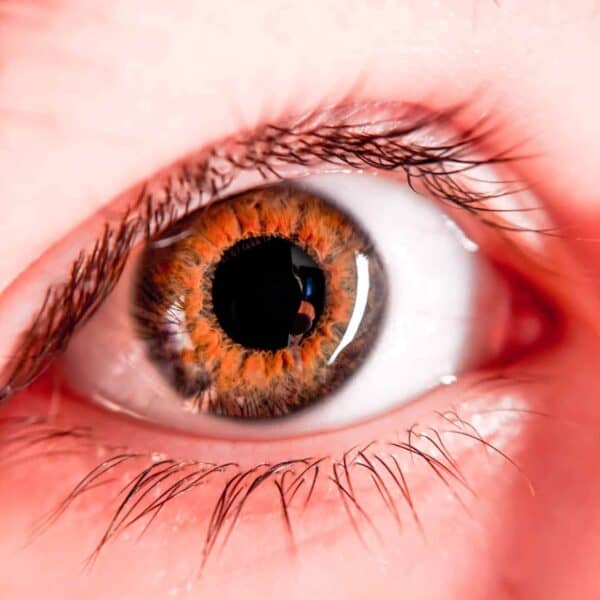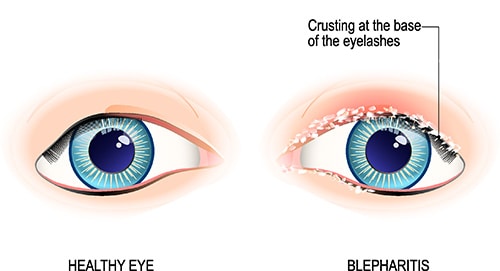
Battling Blepharitis
July 19, 2020

What is blepharitis?
Blepharitis is inflammation or swelling of the eyelids, usually the eyelid margin. The inflammation is typically associated with a bacterial infection of the eyelids or a skin condition similar to dandruff on the eyelashes. The infection is not contagious because it is derived from the person’s own microscopic bacteria that cover the surface of normal, healthy skin. Some people are prone to having an overgrowth of bacteria, especially if proper hygiene is not maintained.
What are the signs and symptoms of blepharitis?

Symptoms vary based on the severity of the blepharitis. Mild cases may result in minor irritation, while severe blepharitis can cause scarring or damage of the eyelids.
– Tender or sore, swollen, red eyelids
– Crusty debris in the eyelashes
– Itchy eyelashes and eyelids
– Dry eyes: burning, watering, blurred vision
– Missing patches of eyelashes (madarosis)
What are the causes of blepharitis?
The most common cause of blepharitis is poor eyelid hygiene, usually seen in people who work in dirty or dusty environments, those who do not remove makeup at the end of the day, and people who touch or rub their eyes frequently with dirty hands.
There are other causes of blepharitis, which are focused more on the build-up of skin debris, oil, and bacteria from the skin’s natural state. An excess of bacteria can cause eyelid infections, such as blepharitis, and hordeola (styes). Similarly, meibomian gland dysfunction (MGD) occurs when the oil glands along the eyelid become blocked and irritated, which is also typically seen in people with blepharitis. In those with severe bacterial overgrowth, a staphylococcal infection can spread to the cornea. Left untreated, a corneal infection can lead to serious problems and potential vision loss.
People with certain dermatological conditions, such as rosacea, eczema, and psoriasis, have a greater risk for blepharitis due to the increased amount of flaky skin around the eyes. Less commonly, blepharitis is associated with Demodex, which are microscopic eyelash mites or parasites.
How is blepharitis diagnosed?
Blepharitis can be diagnosed during a comprehensive eye exam. Since the treatment is based on the cause, it is important to first determine the source of inflammation of the eyelids. This can be done using a magnifying light, called a slit lamp. The eyelashes, eyelids, surrounding skin around the eyes, and tear film are examined for any abnormalities. Based on the findings, the doctor is able to determine the best treatment course. People of all ages can have blepharitis.
What is the treatment for blepharitis?
Eyelid hygiene is key to treating blepharitis. Although blepharitis is usually a chronic problem that does not fully disappear, it can be managed at home with a combination of remedies. Blepharitis, dry eye syndrome, and MGD are all connected, so treating one may alleviate symptoms of another.
– Eyelid scrubs, wipes, or sprays: over-the-counter products specifically designed to clean the lids and lashes
– Warm water and baby shampoo: use a clean washcloth or clean fingers to gently rub the lids and lashes, then rinse
– Hot compresses can be used in conjunction to help treat associated dryness and MGD
– Artificial tears
– Prescription antibiotic ointment to use at bedtime to minimize the risk of further infection from eyelid bacteria
What are the steps to preventing blepharitis?
The best way to prevent blepharitis is to maintain good eyelid hygiene. Even when the eyes are not bothersome, the surrounding area should be cleaned just like any other part of the face. Most people do not think to rub their eyelids and lashes when washing their face because face wash burns if it accidentally gets in the eyes. This is when a separate routine for the eyes comes into play. The treatment for blepharitis can also be used for preventing blepharitis (see above).
Replace makeup regularly. Old and contaminated mascara, eyeliner, and eyeshadow can lead to blepharitis. It also increases the risk of conjunctivitis. If you are noticing symptoms of blepharitis, minimize or stop the use of eye makeup, as it may worsen the condition.